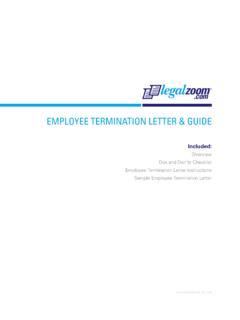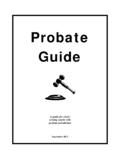Transcription of TERMINATION OF LEASE AGREEMENT & GUIDE
1 TERMINATION OF LEASE AGREEMENT & GUIDE . Included: Overview Dos and Don'ts Checklist TERMINATION of LEASE AGREEMENT Instructions Sample TERMINATION of LEASE AGREEMENT , INC. 2008. 1. Overview The end of a LEASE is as important as its beginning. A change in business climate or in the parties' goals may signal that it's time to terminate the LEASE and release the parties from their duties. A clean break will provide peace of mind, discharge all obligations, and lead to an amicable conclusion. A TERMINATION is the definitive end of the parties' commitments under the LEASE . If well-drafted, it can help prevent future misunderstandings and disputes. Although no document can insulate you from later lawsuits or claims, a clear TERMINATION and release can strengthen your defense if such claims arise. Note that the TERMINATION of a LEASE is not the end of a relationship.
2 It may open avenues of discussion with the other party that might otherwise have been closed. You can review your mutual expectations and concerns, assess the venture's successes and failures, and lay the groundwork for future agreements and interactions. A thorough evaluation of each party's performance allows for a better understanding of what will be required on TERMINATION and can help the parties in all their future dealings. 2. Dos & Don'ts Checklist A landlord and tenant can mutually agree to end a LEASE arrangement at any time. If you have a written LEASE , the TERMINATION of that LEASE must also be in writing. Even if you do not have a written LEASE AGREEMENT , putting the TERMINATION in writing will protect both parties. The TERMINATION should also specify when all of the LEASE liabilities will end and the date on which the tenant will LEASE the premises, and be signed by both parties to be valid.
3 A tenant can almost always break its LEASE , even if the landlord makes statements to the contrary. It may have to pay rent until a new tenant is found, but it will not remain responsible for the apartment itself. If you are a landlord, make sure that your procedures for allowing mid-term TERMINATION of a LEASE are clear and consistent. Consider drafting a procedures manual for use on your properties, and apply its terms equally among your tenants. Failure to do so could result in charges of discrimination and later lawsuits. Your LEASE may require the tenant to make a payment (or a fee) for early TERMINATION . However, this amount can't be more than the landlord's actual and reasonable loss that occurred as a result of the TERMINATION ( , lost rent, advertising costs, etc.). If the tenant pays a fee in connection with the LEASE TERMINATION , and the property is rented immediately thereafter with no corresponding costs, the tenant is entitled to a refund of that entire fee.
4 Be clear about the disposition of money in your AGREEMENT . There are several options provided in the enclosed TERMINATION , and you and the other party should discuss which best applies to your arrangement. To ensure a clean break with few misunderstandings, address issues of the security deposit, last month's rent, and any other monetary sums before signing the TERMINATION . TERMINATION OF LEASE AGREEMENT 1. , INC. 2008. Make sure you have performed all of your contractual duties before signing a TERMINATION . Once the TERMINATION is signed, your original LEASE is void. Review the LEASE and draft a list of each party's obligations and rights. Take a moment to ensure that your interests have been satisfied. Allow each party to spend time reviewing both the LEASE and the TERMINATION . This will reduce the likelihood, or at least the efficacy, of a claim that a party did not understand any terms or how those might affect their rights and obligations.
5 Both parties should review the TERMINATION carefully to ensure that all relevant deal points have been included. It is better to be over-inclusive than under-inclusive. Do not assume that certain expectations or terms are agreed to if they are not stated expressly on the document. The terms of your original LEASE are still in effect, so make sure both parties continue to perform their obligations under that AGREEMENT until the TERMINATION is completed and signed. Sign two copies of the TERMINATION , one for you and one for the other party. Keep your copy of the signed TERMINATION with the LEASE . Once the TERMINATION has been drafted and signed, it is the concluding part of that AGREEMENT and should be treated accordingly. Depending on the nature of its terms, you may decide to have your TERMINATION witnessed or notarized. This will limit later challenges to the validity of a party's signature.
6 If the LEASE or the conditions of your TERMINATION are complicated, do not use the enclosed form. Contact an attorney to help you draft a document that will meet your specific needs. 3. TERMINATION of LEASE AGREEMENT Instructions The following provision-by-provision instructions will help you understand the terms of your TERMINATION . The numbers below ( , Section 1, Section 2, etc.) correspond to the provisions in the AGREEMENT . Please review the document in its entirety before starting the step-by-step process. Introduction. Identifies the document as the TERMINATION of an existing LEASE . Write in the parties and the date on which you want the TERMINATION to be effective. The parties must be the same as those who signed the original AGREEMENT (unless one of the new signers is an agent of the same company that originally signed) and should have the same designations as well ( , the Landlord is still the Landlord, the Tenant is still the Tenant).
7 Recitals. Identifies the document as the TERMINATION of an existing LEASE and explains where your right to terminate the document comes from. Put in the effective date of the LEASE and the section (or paragraph) number of the LEASE that allows you to terminate it. The title of this section is usually TERMINATION or Term and TERMINATION . Note that the recitals require that you attach a signed copy of the LEASE as an exhibit to the TERMINATION . TERMINATION OF LEASE AGREEMENT 2. , INC. 2008. There is a bracketed phrase in the sentence that begins Now, therefore . Include this phrase if you and the other party have agreed that the Tenant will pay money to the Landlord as part of the TERMINATION process. There will be additional information about this possibility below. Section 1: TERMINATION . Explains that both Parties want to terminate the LEASE .
8 This section also acknowledges that if there are any ongoing obligations (for example, a duty to protect the other Party's confidential information), those will survive the TERMINATION . Section 2: Compliance with Obligations or TERMINATION Fee. There are two options provided here, and you should select the one that best suits your arrangement. Delete the paragraph that you do not choose. Note that you will need to change the title of this section depending on which option you pick. In the first (titled Compliance with Obligations ), the language indicates that even after the TERMINATION is signed, the Tenant remains responsible for any rent payments or other obligations that arose before the TERMINATION Date. If there are charges against the Premises that date back to before the TERMINATION Date, the Tenant will be responsible for those as well.
9 The second option (titled TERMINATION Fee ) provides for a one-time payment of a specified amount to satisfy all of the Tenant's remaining (and future) obligations relating to the LEASE or the Premises. Enter the amount of the payment that will be made by the Tenant. The last bracketed part of this paragraph is optional, and states that if the Tenant stays on the Premises after the TERMINATION Date, it will be responsible for additional rent payments for that occupation. In other words, the one-time payment would not be sufficient to cover this obligation. Delete this phrase if it does not suit your AGREEMENT . Section 3: Yield Up. The Tenant's promise to be off of the Premises by the end of the TERMINATION Date and to leave the Premises in the condition required under the LEASE . The last phrase of the section is bracketed, and may be adapted depending on the terms of your LEASE .
10 Review the LEASE provisions. Do they say anything about how the property must be returned ( , broom clean condition, etc.)? If so, you can copy that language into this section to reiterate this AGREEMENT . Section 4: Security Deposit. Describes how the Tenant's security deposit will be distributed. There are two options provided. The first should only be selected if you chose the second option in Section 2 ( , TERMINATION Fee ). This provides that the amount the Tenant deposited initially under the LEASE will be subtracted from the total amount the Tenant owes as a TERMINATION fee. In other words, the Tenant will have to pay a lesser fee based on the money it already paid. The second option is more general, and indicates that the security deposit will be returned as specified in the LEASE and the law generally. Review the terms of your LEASE for additional information about these procedures.
















